Transcription of DOMAIN 1: CLASSROOM STRATEGIES AND …
1 Marzano Art and Science of Teaching Teacher Evaluation Model DOMAIN 1: CLASSROOM STRATEGIES AND BEHAVIORS. Lesson Segments Lesson Segments Lesson Segments Involving Routine Events Addressing Content Enacted on the Spot Learning Goals & Feedback Interacting With New Knowledge Student Engagement What will I do to establish What will I do to help students effectively What will I do to engage students? and communicate learning interact with the new knowledge? Noticing and Reacting when Students are Not goals, track student progress, Identifying Critical Information Engaged and celebrate success? Organizing Students to Interact with New Using Academic Games Providing Clear Learning Knowledge Managing Response Rates Goals and Scales to Measure Previewing New Content Using Physical Movement those Goals Chunking Content into "Digestible Bites" Maintaining a Lively Pace Tracking Student Progress Processing of New Information Demonstrating Intensity and Enthusiasm Celebrating Student Success Elaborating on New Information Using Friendly Controversy Recording and Representing Knowledge Providing Opportunities for Students to Talk about Reflecting on Learning Themselves Rules & Procedures Presenting Unusual or Intriguing Information What will I do to establish or maintain CLASSROOM rules and procedures?
2 Practicing & Deepening Knowledge Adherence to Rules & Procedures Establishing CLASSROOM What will I do to help students practice What will I do to recognize and acknowledge Routines and deepen their understanding of new adherence and lack of adherence to CLASSROOM knowledge? rules and procedures? Organizing Physical Layout of the CLASSROOM for Learning Reviewing Content Demonstrating "Withitness". Organizing Students to Practice and Applying Consequences Deepen Knowledge Acknowledging Adherence to Rules and Procedures Using Homework Examining Similarities and Differences Examining Errors in Reasoning Teacher/Student Relationships Practicing Skills, STRATEGIES , and Processes What will I do to establish and maintain effective DOMAIN 1 identifies the 41 key STRATEGIES revealed by Revising Knowledge relationships with students? research for effective teaching presented in a robust, Understanding Students' Interests and Backgrounds Using Behaviors that Indicate Affection for Students easy-to-understand model of instruction based on the Displaying Objectivity and Control Art and Science of Teaching.
3 Generating & Testing Hypotheses What will I do to help students generate All 41 Key STRATEGIES are organized into and test hypotheses about new knowledge? High Expectations 9 Design Questions, which are further Organizing Students for Cognitively What will I do to communicate high expectations organized into 3 Lesson Segments. Complex Tasks for all students? Engaging Students in Cognitively Complex Demonstrating Value and Respect for Low Tasks Involving Hypothesis Generating and Expectancy Students Testing Asking Questions of Low Expectancy Students Providing Resources and Guidance Probing Incorrect Answers with Low Expectancy Students . 2011 Robert J Marzano. Can only be digitized in iObservation. iObservation is a registered trademark of Learning Sciences International . Marzano Art and Science of Teaching Teacher Evaluation Model DOMAIN 2: DOMAIN 3: DOMAIN 4: PLANNING AND PREPARING REFLECTING ON TEACHING COLLEGIALITY AND PROFESSIONALISM.
4 Planning and Preparing for Evaluating Personal Promoting a Positive Lessons and Units Performance Environment 1. Effective Scaffolding of 1. Identifying Areas of 1. Promoting Positive Information within Lessons Pedagogical Strength and Interactions with Colleagues 2. Lessons within Units Weakness 2. Promoting Positive 3. Attention to Established 2. Evaluating the Effectiveness Interactions about Students Content Standards of Individual Lessons and and Parents Units Planning and Preparing for 3. Evaluating the Effectiveness Promoting Exchange of of Specific Pedagogical Use of Resources and Ideas and STRATEGIES STRATEGIES and Behaviors Technology 1. Seeking Mentorship for 1. Use of Available Traditional Areas of Need or Interest Resources Developing and 2. Mentoring Other Teachers 2. Use of Available Technology Implementing a Professional and Sharing Ideas and Growth Plan STRATEGIES .
5 Planning and Preparing for 1. Developing a Written Growth and Development Plan Promoting District and Special Needs of Students 2. Monitoring Progress Relative School Development 1. Needs of English Language to the Professional Growth 1. Adhering to District and Learners and Development Plan School Rules and 2. Needs of Special Education Students Procedures 3. Needs of Students Who Lack 2. Participating in District and Support for Schooling School Initiatives . 2011 Robert J Marzano. Can only be digitized in iObservation. iObservation is a registered trademark of Learning Sciences International.




